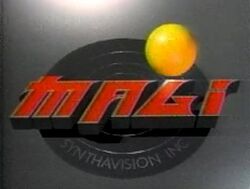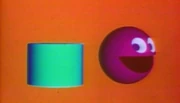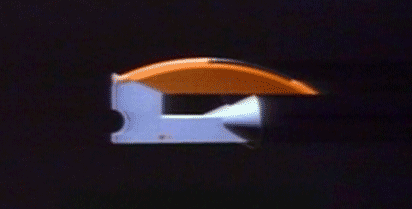mNo edit summary |
(Restoring templates used in the Special:Flags feature.) |
||
| (10 intermediate revisions by 7 users not shown) | |||
| Line 1: | Line 1: | ||
| + | {{Realworld}} |
||
| ⚫ | '''MAGI''', aka '''Mathematical Applications Group, Inc.''', was one of the four companies hired to create the CGI animation for the movie [[ |
||
| + | [[Image:Magi logo.JPG|thumb|250px|The MAGI Logo from 1984-85.]] |
||
| ⚫ | '''MAGI''', aka '''Mathematical Applications Group, Inc.''', was one of the four companies hired to create the CGI animation for the movie ''[[TRON]]''. MAGI/Synthavision was responsible for the most of the CGI animation in the first half of ''TRON'', while [[Triple-I]] work mainly on the second half of the movie. |
||
| ⚫ | |||
| + | |||
| ⚫ | |||
==Beginnings== |
==Beginnings== |
||
| − | MAGI was founded in 1966 by Dr. Mittelman. |
+ | MAGI was founded in 1966 by Dr. Mittelman. In [[Beyond Tron]], Dr. Mittelman talked about the original purpose of MAGI and the discovery of using ray tracing to create CGI images: |
| + | |||
| ⚫ | {{cquote|When MAGI was first started in 1966, we were working primarily with the government doing what's called nuclear radiation transport. Worrying about, if you had a nuclear reactor, how much radiation would come out and what kind of radiation dose would people get. The way we did that was to describe three dimensional objects, and then follow around the nuclear radiation, follow it through its path through the material. One day we realized that if we followed light rays instead of nuclear radiation, we could simulate photography. We could simulate following the light rays from the sun to the object, from the object in through the camera lens to the film. If we could just calculate how much light hit each point on the film, we could make a photograph of things.}} |
||
| ⚫ | |||
| − | <br><br> |
||
===Synthavision=== |
===Synthavision=== |
||
[[Image:Synthavisionfilm.JPG|thumb|A still from the Synthavision Demo shown at SIGGRAPH.]] |
[[Image:Synthavisionfilm.JPG|thumb|A still from the Synthavision Demo shown at SIGGRAPH.]] |
||
| − | In 1967, MAGI developed a software program called, "Synthavision" to create CGI images and movies. |
+ | In 1967, MAGI developed a software program called, "Synthavision" to create CGI images and movies. Synthavision was one of the first systems to implement the later concept of ray-tracing for making images. The software was a constructive solid geometry (CSG) system, in that the geometry was solid primitives with combinatorial operators (such as Boolean operators). Synthavision's modeling method doesn't use polygons or wireframe meshes that most CGI companies use today. The combination of the solids modeling and ray tracing (later to become plane firing) made it a very robust system that could generate high quality images. In 1972, MAGI/SynthaVision was started by Robert Goldstein, with Bo Gehring and Larry Elin covering the design and film/TV interests, respectively. |
| − | MAGI created the world's first CGI advertisement for IBM. |
+ | MAGI created the world's first CGI advertisement for IBM. It featured 3D letters that flew out of an office machine. |
==TRON== |
==TRON== |
||
| − | In 1981, MAGI was hired by Disney to create half of the majority of the 20 minutes of CGI needed for the movie |
+ | In 1981, MAGI was hired by Disney to create half of the majority of the 20 minutes of CGI needed for the movie ''TRON''. 20 minutes of CGI animation, in the early 1980s, was extremely gutsy, and so MAGI was a portion of the CGI animation, while other companies were hired to do the other animation shots. |
| − | Since Sythnavision was easy to animate and could create fluid motion and movement, MAGI was assigned with most of |
+ | Since Sythnavision was easy to animate and could create fluid motion and movement, MAGI was assigned with most of ''TRON's'' action sequences. These classic scenes include the Lightcycle sequence and Clu's tank and recognizer pursuit scene. |
| − | [[Image: |
+ | [[Image:Lightcycle behindthescenes.gif]] |
| − | Despite the high quality images that Sythnavision was able to create, the CSG solids modeling could not create anything with complex shapes and multiple curves, so simpler objects like the |
+ | Despite the high quality images that Sythnavision was able to create, the CSG solids modeling could not create anything with complex shapes and multiple curves, so simpler objects like the light cycles and tanks where assigned to MAGI. |
| − | MAGI was given $1.2 million to finance the animation needed for |
+ | MAGI was given $1.2 million to finance the animation needed for ''TRON''. MAGI needed more R&D and many other engineers who were working in government contacts at MAGI were assigned back into MAGI's "Synthavision" division. |
| − | MAGI sped up the process of supplying its work to Disney Studios in Burbank by a |
+ | MAGI sped up the process of supplying its work to Disney Studios in Burbank by a transcontinental computer hook-up. Before each scene was finalized in MAGI's lab in Elmsford, N.Y., it was previewed on a computer monitor at Disney. Corrections could then be made in the scene immediately. Previously, the only way of previewing the scene was to film it, ship it to Burbank, get corrections made, ship it back to Elmsford, and continue this "ping-ponging" until the scene was correct. The computer link cut between two-and-a-half to five days from the creation of each scene.<ref>http://design.osu.edu/carlson/history/tree/magi.html</ref> |
| − | During the production of |
+ | During the production of ''TRON'', animators and computer image choreographers [[Bill Kroyer]] and Jerry Rees invited John Lasseter (who would later co-found the famous CGI studio, Pixar) to see some the light cycle animation. Lasseter said in "The Making of TRON" featurette, that the light cycle animation was the first CGI animation he had ever seen. |
| − | ==After |
+ | ==After TRON== |
| − | In 1983, Disney commissioned MAGI to create a test film featuring characters from the children's book "Where the Wild Things Are". |
+ | In 1983, Disney commissioned MAGI to create a test film featuring characters from the children's book "Where the Wild Things Are". The test used CGI animation for the background and traditional 2-D animation for the main of the book character, Max, and his dog. What is notable is that this test film was directed by John Lasseter, of Toy Story and Pixar fame. |
| − | In 1984, MAGI opened an office in Los Angeles, California. |
+ | In 1984, MAGI opened an office in Los Angeles, California. This office was headed by [[Richard Taylor]], who worked as special effects supervisor while at Triple-I. Unfortunately, this LA office was close shortly after its establishment. |
| − | Soon after, MAGI was sold to a Canadian firm, Bidmax, and the employees left to other CGI companies and universities. |
+ | Soon after, MAGI was sold to a Canadian firm, Bidmax, and the employees left to other CGI companies and universities. Sadly, the founder of MAGI, Dr. Phillip Mittelman passed away in 2000. |
| − | In 1997, Ken Perlin, who worked on |
+ | In 1997, Ken Perlin, who worked on ''TRON'', was awarded an Technical Achievement Award from the Academy of Motion Picture Arts and Sciences for "Perlin Noise, a technique used to produce natural appearing textures on computer generated surfaces for motion picture visual effects."<ref>http://mrl.nyu.edu/~perlin/doc/oscar.html</ref> |
== References == |
== References == |
||
<references/> |
<references/> |
||
| + | |||
| + | [[es:Mathematical Applications Group, Inc.]] |
||
| + | [[Category:Production]] |
||
| + | [[Category:TRON]] |
||
| + | [[Category:Real Life Companies]] |
||
Revision as of 12:25, 9 March 2016

|
This article is written from a Real World perspective. |

|

The MAGI Logo from 1984-85.
MAGI, aka Mathematical Applications Group, Inc., was one of the four companies hired to create the CGI animation for the movie TRON. MAGI/Synthavision was responsible for the most of the CGI animation in the first half of TRON, while Triple-I work mainly on the second half of the movie.
MAGI modeled and animated the Light Cycles, Recognizers and Light Tanks.
Beginnings
MAGI was founded in 1966 by Dr. Mittelman. In Beyond Tron, Dr. Mittelman talked about the original purpose of MAGI and the discovery of using ray tracing to create CGI images:
| “ | When MAGI was first started in 1966, we were working primarily with the government doing what's called nuclear radiation transport. Worrying about, if you had a nuclear reactor, how much radiation would come out and what kind of radiation dose would people get. The way we did that was to describe three dimensional objects, and then follow around the nuclear radiation, follow it through its path through the material. One day we realized that if we followed light rays instead of nuclear radiation, we could simulate photography. We could simulate following the light rays from the sun to the object, from the object in through the camera lens to the film. If we could just calculate how much light hit each point on the film, we could make a photograph of things. | ” |
Synthavision

A still from the Synthavision Demo shown at SIGGRAPH.
In 1967, MAGI developed a software program called, "Synthavision" to create CGI images and movies. Synthavision was one of the first systems to implement the later concept of ray-tracing for making images. The software was a constructive solid geometry (CSG) system, in that the geometry was solid primitives with combinatorial operators (such as Boolean operators). Synthavision's modeling method doesn't use polygons or wireframe meshes that most CGI companies use today. The combination of the solids modeling and ray tracing (later to become plane firing) made it a very robust system that could generate high quality images. In 1972, MAGI/SynthaVision was started by Robert Goldstein, with Bo Gehring and Larry Elin covering the design and film/TV interests, respectively.
MAGI created the world's first CGI advertisement for IBM. It featured 3D letters that flew out of an office machine.
TRON
In 1981, MAGI was hired by Disney to create half of the majority of the 20 minutes of CGI needed for the movie TRON. 20 minutes of CGI animation, in the early 1980s, was extremely gutsy, and so MAGI was a portion of the CGI animation, while other companies were hired to do the other animation shots.
Since Sythnavision was easy to animate and could create fluid motion and movement, MAGI was assigned with most of TRON's action sequences. These classic scenes include the Lightcycle sequence and Clu's tank and recognizer pursuit scene.
Despite the high quality images that Sythnavision was able to create, the CSG solids modeling could not create anything with complex shapes and multiple curves, so simpler objects like the light cycles and tanks where assigned to MAGI.
MAGI was given $1.2 million to finance the animation needed for TRON. MAGI needed more R&D and many other engineers who were working in government contacts at MAGI were assigned back into MAGI's "Synthavision" division.
MAGI sped up the process of supplying its work to Disney Studios in Burbank by a transcontinental computer hook-up. Before each scene was finalized in MAGI's lab in Elmsford, N.Y., it was previewed on a computer monitor at Disney. Corrections could then be made in the scene immediately. Previously, the only way of previewing the scene was to film it, ship it to Burbank, get corrections made, ship it back to Elmsford, and continue this "ping-ponging" until the scene was correct. The computer link cut between two-and-a-half to five days from the creation of each scene.[1]
During the production of TRON, animators and computer image choreographers Bill Kroyer and Jerry Rees invited John Lasseter (who would later co-found the famous CGI studio, Pixar) to see some the light cycle animation. Lasseter said in "The Making of TRON" featurette, that the light cycle animation was the first CGI animation he had ever seen.
After TRON
In 1983, Disney commissioned MAGI to create a test film featuring characters from the children's book "Where the Wild Things Are". The test used CGI animation for the background and traditional 2-D animation for the main of the book character, Max, and his dog. What is notable is that this test film was directed by John Lasseter, of Toy Story and Pixar fame.
In 1984, MAGI opened an office in Los Angeles, California. This office was headed by Richard Taylor, who worked as special effects supervisor while at Triple-I. Unfortunately, this LA office was close shortly after its establishment.
Soon after, MAGI was sold to a Canadian firm, Bidmax, and the employees left to other CGI companies and universities. Sadly, the founder of MAGI, Dr. Phillip Mittelman passed away in 2000.
In 1997, Ken Perlin, who worked on TRON, was awarded an Technical Achievement Award from the Academy of Motion Picture Arts and Sciences for "Perlin Noise, a technique used to produce natural appearing textures on computer generated surfaces for motion picture visual effects."[2]

